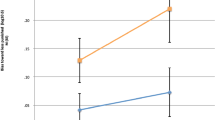Abstract
Task performance of 12 pervasive hyperactives and controls was studied in a divided attention reaction time experiment. The two groups differed with respect to task efficiency. The hyperactives were slower than controls, had more variable reaction times, and made more frequent errors. Task inefficiency could not be explained by a deficiency in divided attention or impulsive responding in the hyperactive group. Further, the observed differences in IQ between the groups could not account for the differential performance finding. It is concluded that input and/or output processes, probably in combination with energetical factors, might be disturbed in hyperactive children.
Similar content being viewed by others
References
American Psychiatric Association. (1980).Diagnostic and statistical manual of mental disorders (3rd ed.). Washington, D.C.: Author.
Bruning, J. L., & Kintz, B. L. (1968).Computational handbook of Statistics (pp. 191–194). Glenview, Illinois: Scott, Foresman.
Douglas, V. I. (1983). Attentional and cognitive problems. In M. Rutter (Ed.),Developmental neuropsychiatry (pp. 280–329). New York: Guilford.
Kazdin, A. E., Esveldt-Dawson, K., & Loar, L. L. (1983). Correspondlence of teacher ratings and direct observations of classroom behavior of psychiatric inpatient children.Journal of Child Psychology and Psychiatry, 11, 549–564.
Lambert, N. M., Sandoval, J., & Sassone, D. (1978). Prevalence of hyperactivity in elementary school children as a function of social system definers.American Journal of Orthopsychiatry, 48, 446–463.
Ollman, R. (1977). Choice reaction time and the problem of distinguishing task effects from strategy effects. In S. Dornic (Ed.),Attention and performance (Vol. 6, pp. 99–113). Hillsdale, New Jersey: Erlbaum.
Pachella, R. G. (1974). The interpretation of reaction time in information-processing research. In B. Kantowitz (Ed.),Human information processing: Tutorial in performance and recognition (pp. 41–82). Potomac, Maryland: Erlbaum.
Sanders, A. F. (1983). Toward a model of stress and human performance.Acta Psychologica, 53, 61–97.
Schachar, R., Rutter, M., & Smith, A. (1981). The chracteristics of situationally and pervasively hyperactive children: Implications for syndrome definition.Journal of Child Psychology and Psychiatry, 22, 375–392.
Schneider, W., & Shiffrin, R. M. (1977). Controlled and automatic human information processing: I. Detection, search and attention.Psychological Review, 84, 1–66.
Sergeant, J. A., & Scholten, C. A. (1983). A stages of information approach to hyperactivity.Journal of Child Psychology and Psychiatry, 24, 49–60.
Sergeant, J. A., & Scholten, C. A. (1985a). On resource strategy limitations in hyperactivity: Cognitive impulsivity reconsidered.Journal of Child Psychology and Psychiatry, 26, 97–109.
Sergeant, J. A., & Scholten, C. A. (1985b). On data limitations in hyperactivity.Journal of Child Psychology and Psychiatry, 26, 111–124.
Sergeant, J. A., van Velthoven, R., & Virginia, A. (1979). Hyperactivity, impulsivity and reflectivity: An examination of their relationship and implications for clinical child psychology.Journal of Child Psychology and Psychiatry, 20, 47–60.
Shiffrin, R. M., & Schneider, W. (1977). Controlled and automatic human information processing: Perceptual learning, automatic attending, and a general theory.Psychological Review, 84, 127–190.
Author information
Authors and Affiliations
Additional information
The authors wish to thank L. Leertouwer for making the drawings, and the students Ellie Wekking and Sipke Boorsma for their selection procedure work. This research was supported by a grant from the Netherlands Foundation for the Advancement of Pure Research (ZWO) and by the Professor Duijker Fund.
Rights and permissions
About this article
Cite this article
van der Meere, J., Sergeant, J. A divided attention experiment with pervasively hyperactive children. J Abnorm Child Psychol 15, 379–391 (1987). https://doi.org/10.1007/BF00916456
Revised:
Issue Date:
DOI: https://doi.org/10.1007/BF00916456




